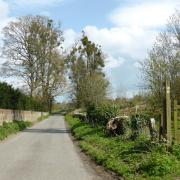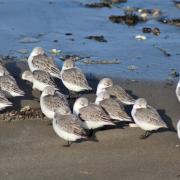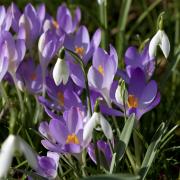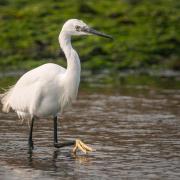Daffodils are everywhere this month and the spectacle of seeing them en masse is sure to lift your spirit as spring gets underway in the garden. These reliable bulbs pop up across the country in gardens and road verges and it’s a lovely thing to do to wrap up warm and go for a stroll amongst these iconic blooms.

There is great diversity in the shapes and colours of Narcissi, from the common yellows to pastel pinks and white, with single, double and split corona forms. The dwarf varieties such as the ever-popular ‘Tete-a-Tete’ look charming lining paths or in containers, and at the other end of the scale are giants such as ‘Breck’s Colossal’. I particularly love the subtle wild native daffodil Narcissus pseudonarcissus, which inspired Wordsworth’s poem, and the white with orange-fringed centre of the dainty, scented pheasant’s eye, Narcissus poeticus, another old variety, one of the first to be cultivated, and ideal for naturalising.

It’s important to remember to take care though where you plant your daffodils so that they don’t cross-pollinate and threaten our native British daffodil. English Heritage has mass planted native daffodils at some of their sites and is encouraging home gardeners to plant more native and historic cultivar bulbs, so they are well worth looking out for. Older varieties also naturalise best, making them ideal for areas you’d like to create large drifts in grass, or under canopies of blossom confetti. You may get inspired to grow a collection in containers or in clumps in garden beds and all varieties prefer well-drained soil with most preferring sunny spots and others in light shade.

Daffodils combine with the first of the tulips, contrast dramatically with violet muscari, bright blue scilla or iridescent hyacinths, and look attractive popping up through spring bedding, such as polyanthus, bellis and erysimum. Planting bulbs under deciduous trees is a natural choice. From glorious prunus and malus blossom to the range of magnolias, you are assured of a reliable and colourful display, with minimum effort as bulbs are easy to grow and resilient, most will naturalize over time and pop up unaided year after year. Bulbs are little powerhouses of stored energy and with planning you can have a succession of blooms to enjoy from January to May, from snowdrops, winter aconites and crocuses, through snowflakes, scillas, muscari, fritillaries, hyacinths and narcissi, to tulips, alliums, and camassias.

There are some wonderful Hampshire gardens open through The National Garden Scheme, check their website for any covid arrangements, such as pre-booking before setting out. At Bere Mill in Whitchurch, you will find carpets of narcissi naturalised over many years spreading down to the riverbanks of The Upper Test. The beauty of the site, with its water meadows and the ever-present clear water, is central to the ethos of this tranquil place and has been augmented and re-vitalised by owners Rupert and Elizabeth Nabarro over many years with naturalistic planting and rustic detailing. Bulbs are accompanied by blossom from Japanese prunus, unfurling fresh green foliage, hellebores and marginal choices, such as vibrant irises.

A delightful meadow effect from a succession of bulbs greets the visitor at Beechenwood Farm in Odiham, with species tulips, narcissi, cowslips, fritillaries, muscari, scilla and bluebells under a canopy of a deciduous woodland. The effect you see has been created since 1972 by owners Michael and Sarah Heber-Percy, who started with no bulbs and over the years have added to the floral carpet. Originally they used tall daffodils but found they were blown over in the wind so instead planted miniature types such as ‘Tete-a-Tete’. Closer to the house the garden is more formal and includes mixed bulb containers.
Two National Trust properties that are also ideal for a stroll amongst spring bulbs are Hinton Ampner and Mottisfont. Again check their websites before visiting for pre-booking. Hinton Ampner in Bramdean has wonderful formal planting with a succession of bulbs and bedding, thousands being added each year, giving some wonderful combinations to inspire from March to May. In addition the garden is famous for its elegant magnolias, scented swathes of narcissi in the orchard under boughs of blossom and atmospheric woodland walks amongst bluebells. Drifts of narcissi under ancient trees and in the specially designed winter garden draw the eye at Mottisfont near Romsey as do richly-scented hyacinths in the parterre and chionodoxa down the lime tree avenue. There is a tradition of bulk-planting a single variety of bulbs in an area, which continues to be adopted and could be translated to the home garden readily. As spring progresses massed tulips continue the exuberance in the parterres and walled gardens. On the wider estate bluebells provide further beauty from mid April to early May.

Growing tips
Daffodils are incredibly easy and reliable to grow, they like well-drained soil, sun or light shade. If soil is heavy, mix grit into the base of the planting hole.
Plant in August and September at a depth three times the height if your bulbs are in beds, borders or containers.
Plant in drifts, in garden beds, under deciduous trees or naturalized in grass. If planting in lawns, plant deeper at 15cm.
Preserve the strength of the bulb by deadheading spent blooms and allowing the foliage to die down naturally, daffodils need the energy from the foliage to the bulb to produce next year’s flowers.
In pots, make sure you check the soil regularly, it should feel moist, don’t let them dry out and if we experience a dry spring it’s just as well to water your daffodils to keep them happy, they can tolerate wet quite well.
If you are cutting daffodils to bring indoors, they should be kept alone in a vase as the fluid that secretes from within the stem is know to wilt other flowers.



























